Postcards from:
Big Bear Lake California
Bangkok Thailand
Calcutta India
Angkor Wat Cambodia
Aranyaprathet
border
Angkor Wat
First Day
Angkor Wat
Second Day
Angkor Wat
Third Day
Bangkok Thailand
Big Bear Lake California
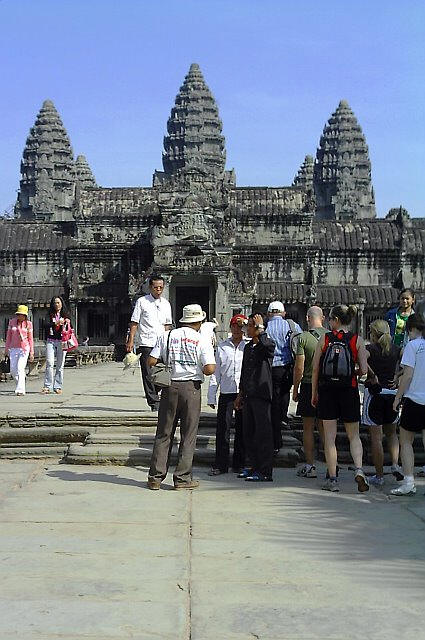
Angkor Wat: A tour
group prepares to enter the main gateway at the end of the long
causeway. This is the iconic view of the vast monument.
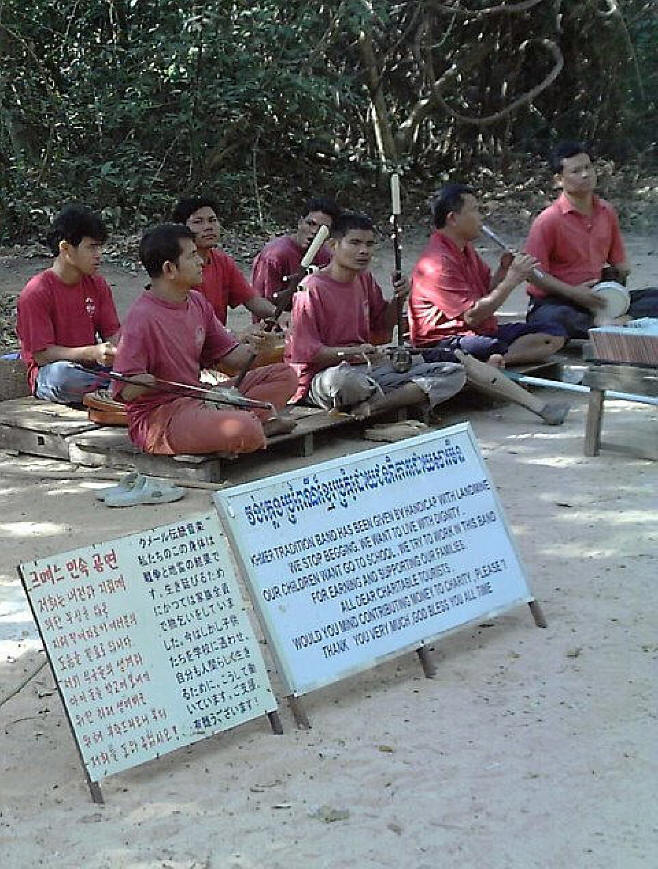
Angkor Wat: People who have lost limbs to land mines now try to make
a living performing traditional music for the enjoyment of visiting
foreign tourists. They are not paid, but live on donations from the
visitors.
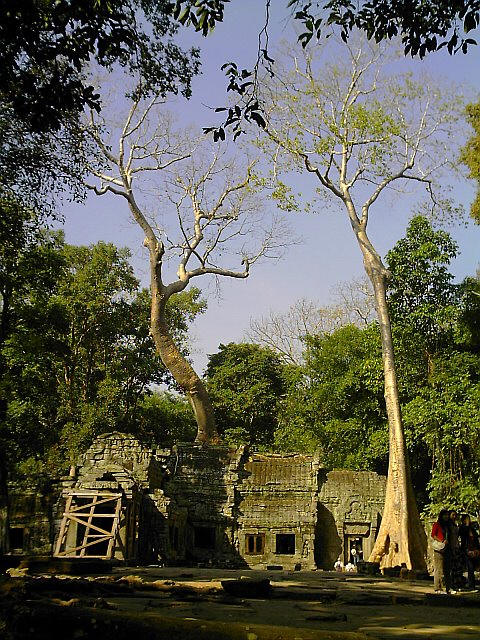
Angkor Wat: Restoration work may be seen at many of the ruin sites.
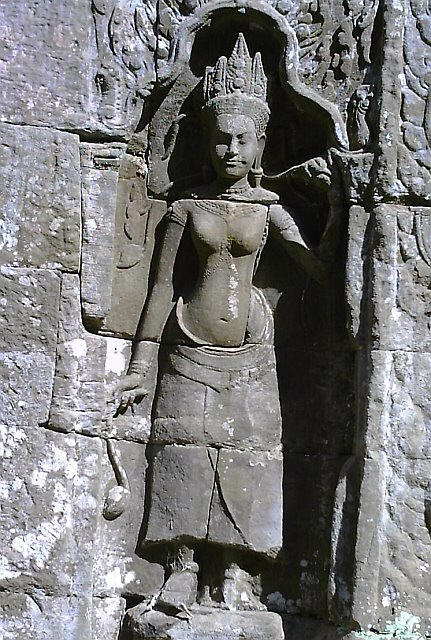
Angkor Wat: Bas relief sculptures like these adorn most flat stone
surfaces around the temple compounds.
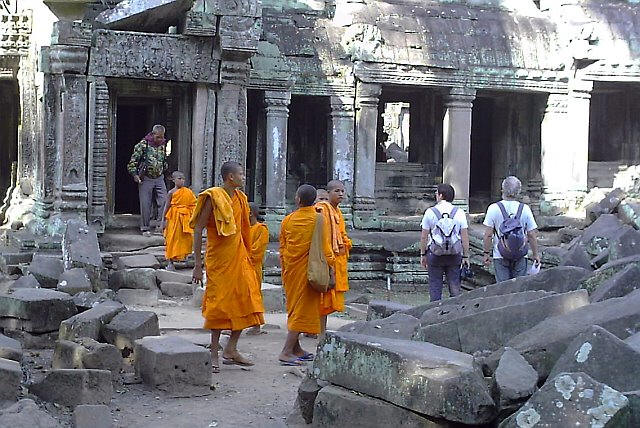
Angkor Wat: Buddhist monks like these are seen everywhere around the
temple compounds.
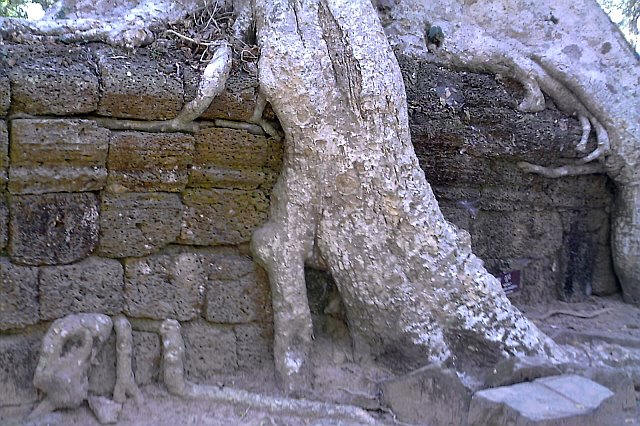
Angkor Wat: Giant roots of trees planted long after the ancient
temples were constructed continue to grow around and through the old
structures.
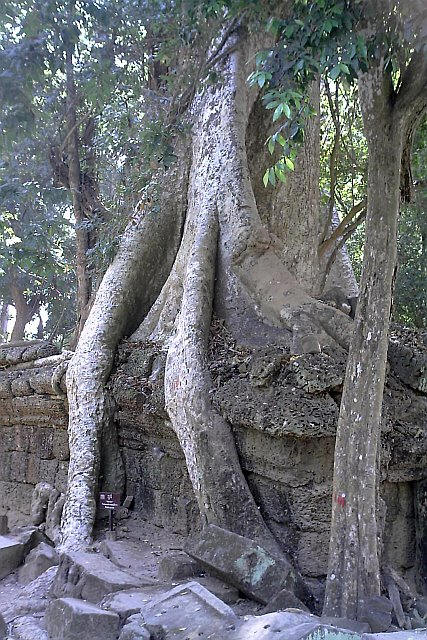
Angkor Wat: Giant roots of trees planted long after the ancient
temples were constructed continue to grow around and through the old
structures.
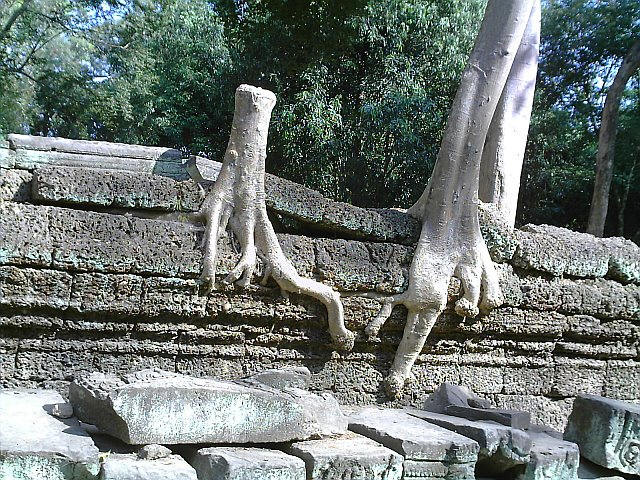
Angkor Wat: Trees planted long after the ancient temples were
constructed continue to grow around and through the old structures.
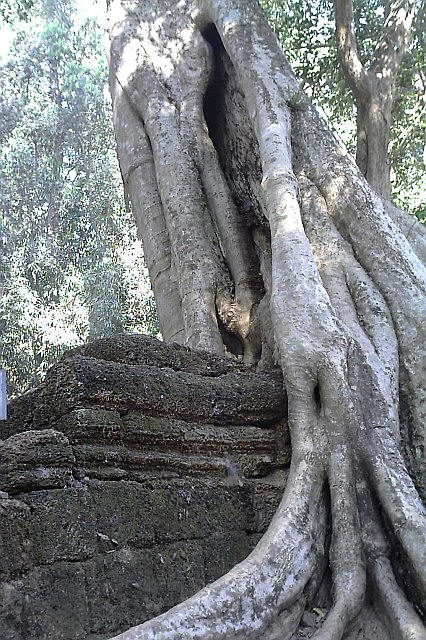
Angkor Wat: Giant roots of trees planted long after the ancient
temples were constructed continue to grow around and through the old
structures.
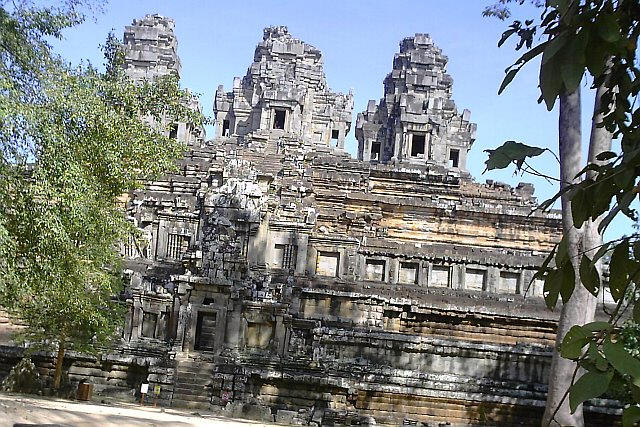
Angkor Wat: A view from the back side of the main temple structure.
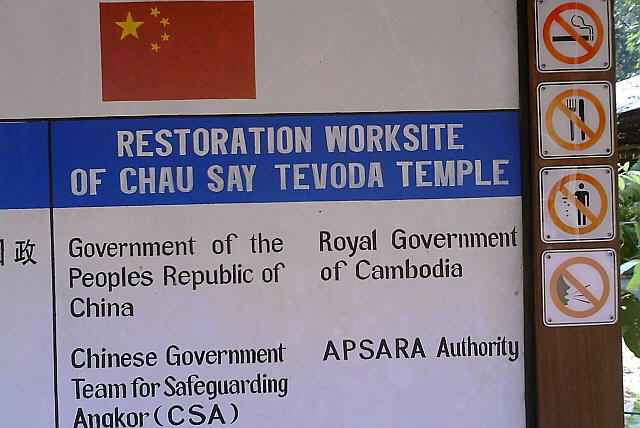
Angkor Wat: Sign identifies the Chinese sponsorship of restoration
work here at the monument.
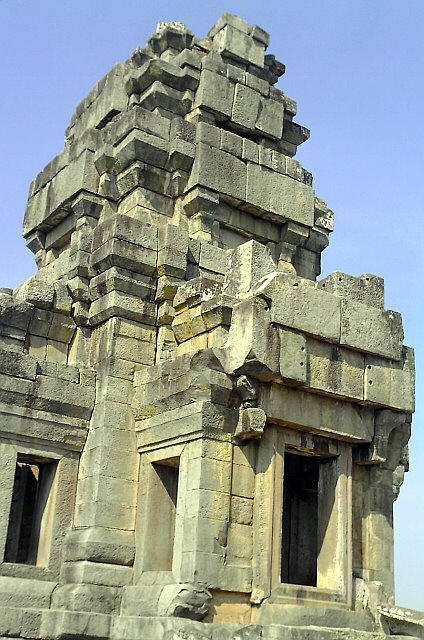
Angkor Wat: Close up of one of the towers in the main complex.
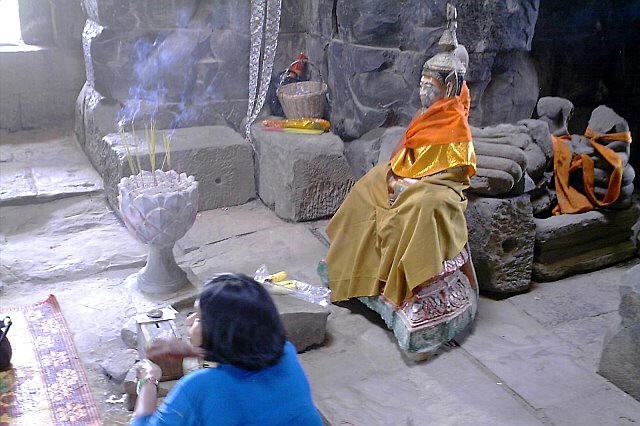
Angkor Wat: Many sections of the ruins are in active use by Buddhist
monks and nuns. Here, some of the statues have been adorned in
colorful cloth.
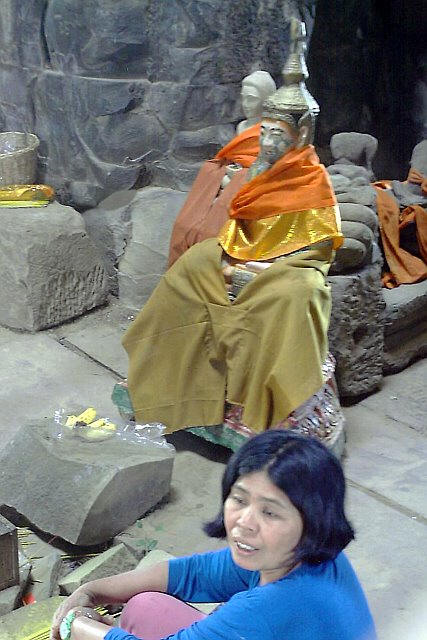
Angkor Wat: Many sections of the ruins are in active use by Buddhist
monks and nuns. Here, some of the statues have been adorned in
colorful cloth.
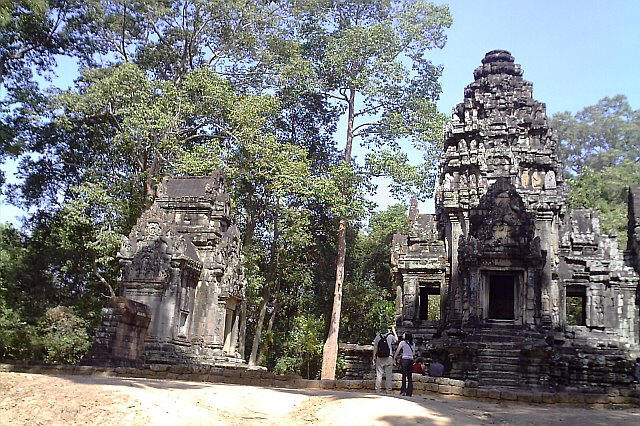
Angkor Wat: View of one of the towers in the main complex.
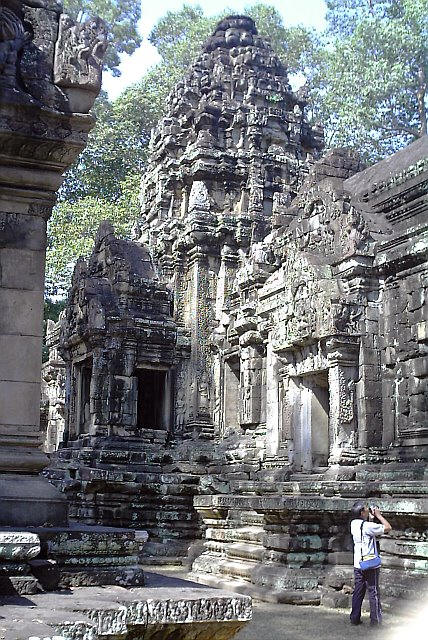
Angkor Wat: View of one of the towers inside the main complex.
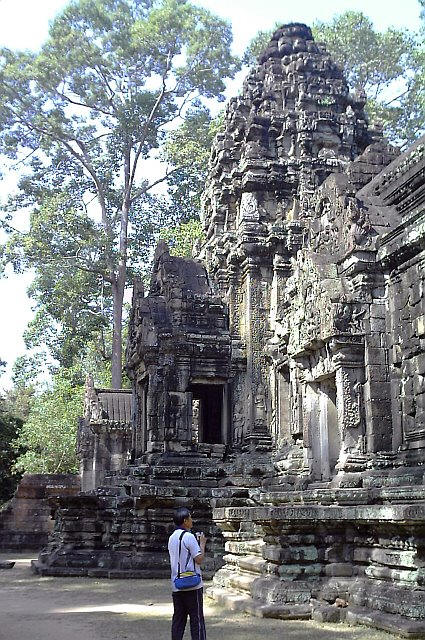
Angkor Wat: View of one of the towers inside the main complex.
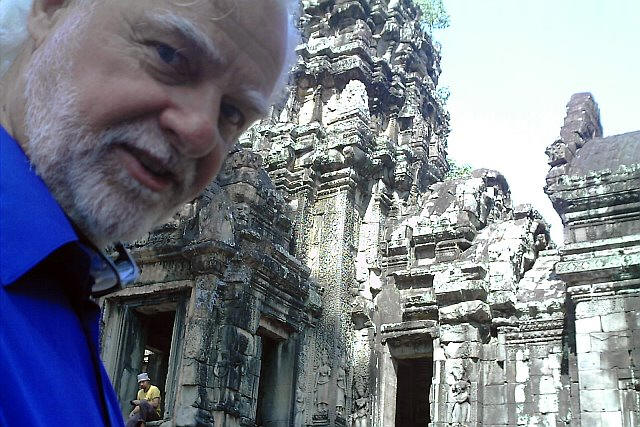
Angkor Wat: A photo to show one of the places I visited.
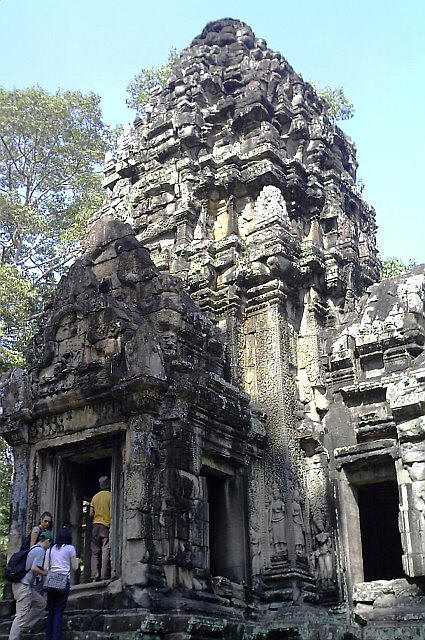
Angkor Wat: View of one of the towers inside the main complex.
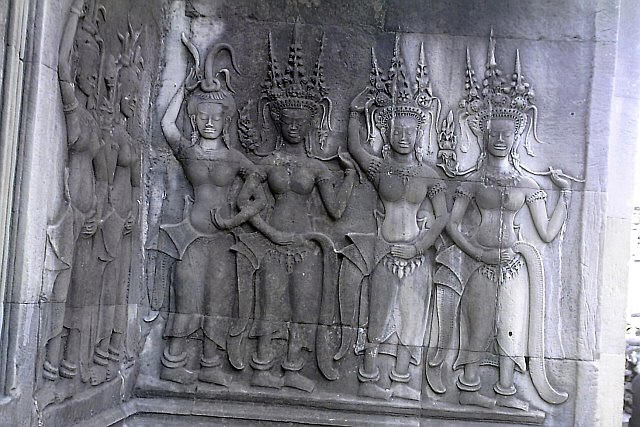
Angkor Wat: Bas
relief sculptures like these adorn most flat stone surfaces around
the temple compounds. While similar, no two are alike and even the
models appear to be unique.
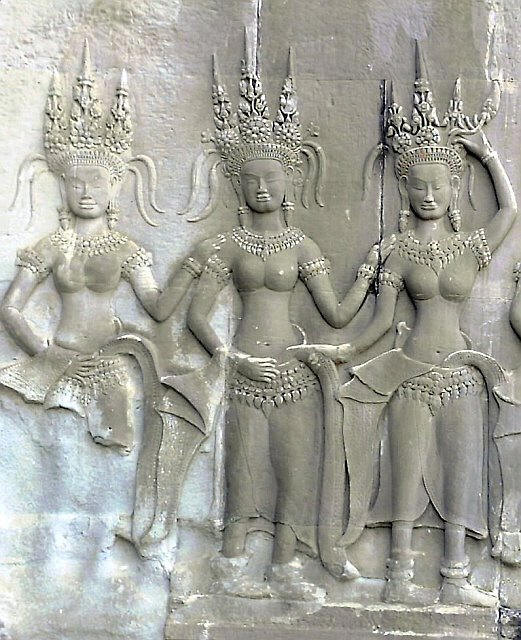
Angkor Wat: Bas relief sculptures like these adorn most flat stone
surfaces around the temple compounds. While similar, no two are
alike and even the models appear to be unique.
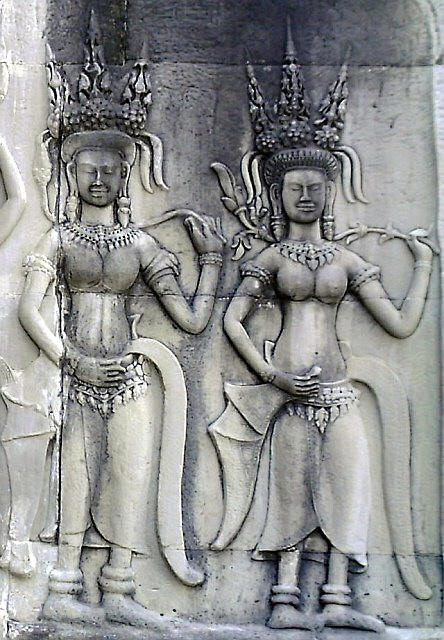
Angkor Wat: Bas relief sculptures like these adorn most flat stone
surfaces around the temple compounds. While similar, no two are
alike and even the models appear to be unique.
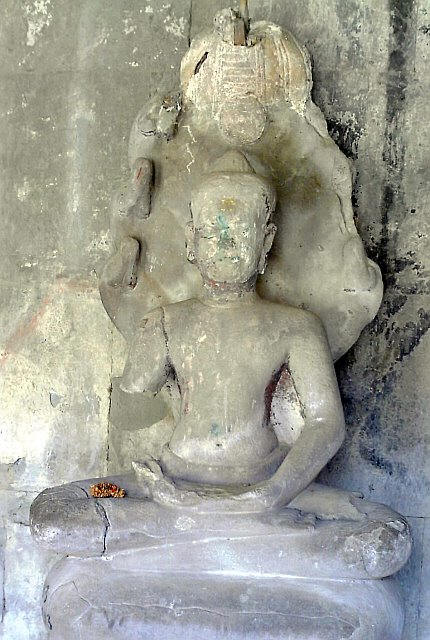
Angkor Wat: Bas
relief sculptures like these adorn most flat stone surfaces around
the temple compounds.
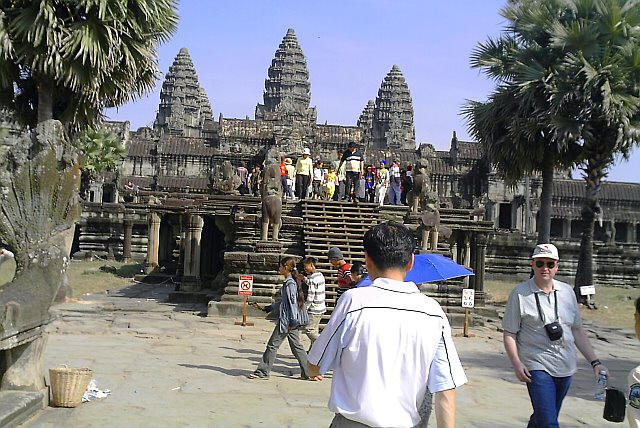
Angkor Wat: An organized tour group prepares to enter the main
entryway.

Angkor Wat: An organized tour group prepares to enter the main
entryway.
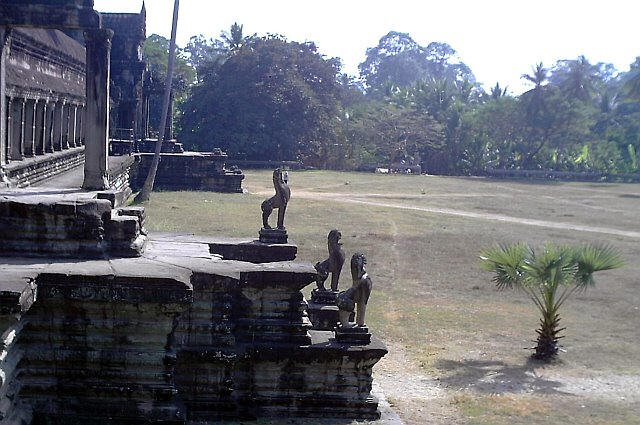
Angkor Wat: Walking around
the outside of the temple compounds provides another perspective on
the monument.
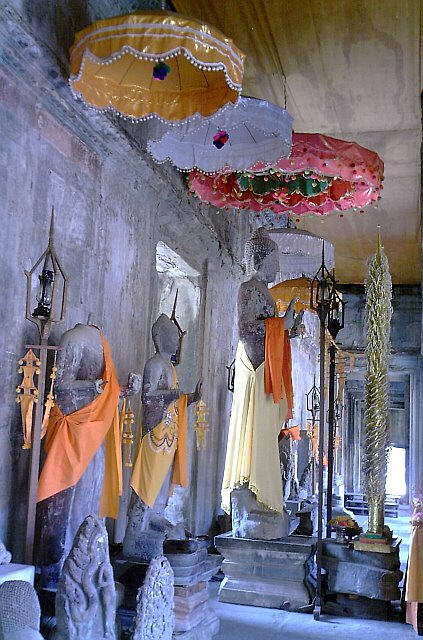
Angkor Wat: Many sections of the ruins are in active use by Buddhist
monks and nuns. Here, some of the statues have been adorned in
colorful cloth.
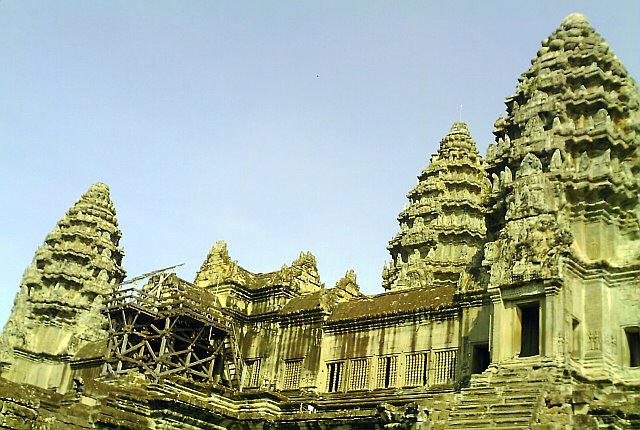
Angkor Wat: Another section of the main temple compound.
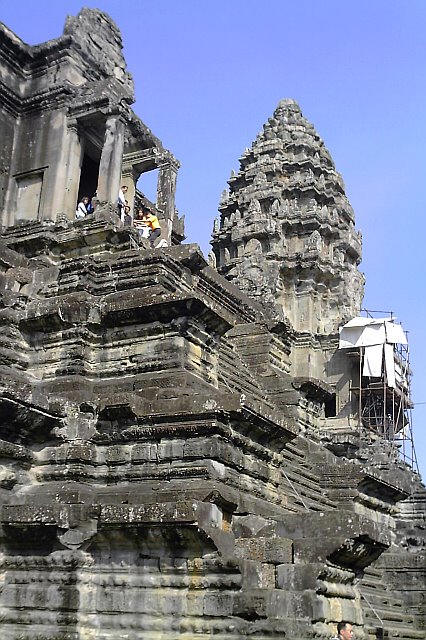
Angkor Wat: A number of the structures have steep stairways like
this one around the temple compounds.
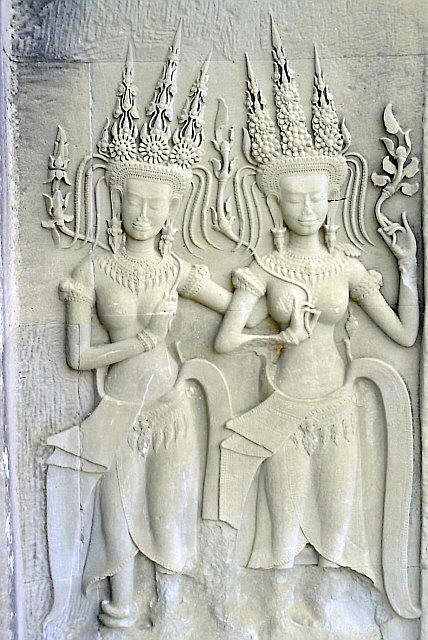
Angkor Wat: Bas relief sculptures like these adorn most flat stone
surfaces around the temple compounds. While similar, no two are
alike and even the models appear to be unique. |
  25
December 2006 25
December 2006
Holiday Greetings from Angkor Wat,
THIRD DAY PHOTOS PAGE
Siam Reap is
the gateway to the fabulous ruins of Angkor Wat. This is my
second visit, the first being back in 2002. I took so many
photographs this time I've decided to break up the presentation
into several web pages... as well as providing access to my
Kodakgallery albums which display the photos as a full screen
slide show.
After leaving Kolkata India,
Bangkok provided a three week refuge from the Indian
misadventure. Eventually, the new 30 day Thailand visa again
approached expiration and I jumped over to Cambodia for a return
visit to the fabulous Angkor Wat archaeological park previously
visited some four years earlier. I love ruins.
Today is Christmas and despite
the presence of very few Christians in the country, music and
decorations insure American visitors will not be deprived of the
holiday spirit. My hotel has an elaborately decorated ten foot
tall tree in the lobby and traditional Christmas music is piped
into all public areas of the hotel every morning and evening. I
think they only have one XMas CD as the selections often
repeat... though I suspect few of the indigenous folk notice
- most speak only Khmer. Around the hotels one hears plenty of
English, however. Parents must teach newborns "hello papa" as
their first words. Tiny tots commonly stare and pronounce the
greeting, awkwardly managing feeble hand gestures resembling a
"wave bye-bye." On the streets I am never far from someone
yelling: "Sir! Want Tuktuk?" This is the high season, but there
must be at least ten times as many of these motorcycle pulled
carts as are needed by tourists and drivers are anxious to find
someone willing to pay $10 for a full day of their services.
Most foreign visitors arrive with a package tour which
provides deluxe air conditioned buses. It is only the young
backpackers and other intrepid solo travelers like me that must
make independent arrangements. The manager of my four star $70 Somadevi
Angkor Hotel, Ms. Revira says she rarely sees independent
travelers in her hotel. So unusual is my presence she invited me
to be her guest at the lavish Christmas eve party around the
pool last night. So much for my lackadaisical efforts to stay on
a diet!
Today I again walked-climbed the
extensively restored ruins of the vast Angkor
Wat archaeological park. Hindus built the temples during a
period spanning four centuries. Starting around 800CE a series
of powerful rulers undertook massive building campaigns rivaling
those of the Egyptians or the First Emperor of China. The
dominant religion of the region shifted back and forth between
Hinduism and Buddhism. Originally created as Hindu temples, the
Buddhists co-opted the structures and added their own statues of
revered monks and the Buddha... only to have most of them
destroyed or defaced by later Hindu conquerors. Today, broken
relics of grander times are protected by orange robed Buddhist
monks and white clad nuns. Here and there throughout the
monument statues are draped in orange, yellow and gold cloth,
burning incense nearby adds to the exotic atmosphere and is a
reminder that this is first and foremost a spiritual place for
many. Spending a major Christian holiday walking Hindu temples
in a predominantly Buddhist country is a heady experience.
The ancient architects liked
steep inclines and tall structures so some of the stairs to the
top of the tallest temples have steps ascending at a 70 degree
angle. Many of the steps are less than six inches deep and rise
18 inches each step. On my last climb and descent I suffered a lactic
acid attack and
my leg muscles threatened to collapse. Needless to say, I slowed
the pace down the steep incline and steadied myself with
precarious handholds along the occasional wall edges. It is now
36 hours later and it still hurts to stand up! The tuktuk wagon
bounced along the uneven roads between temples spanking me all
the while. Last night crawling into bed became a test of my
ability to tolerate pain as I must surely have badly bruised the
tailbone judging by the tenderness.
I trust that your holidays are
full of joy and that you can look forward to a happy and
eventful new year.
Peace,
Fred Bellomy
PS: I have taken an obscene
number of photographs while touring the ruins of Angkor Wat this
time. So far they remain mostly unannotated and unorganized. Eventually I hope
to get to the task of forming order out of chaos. F
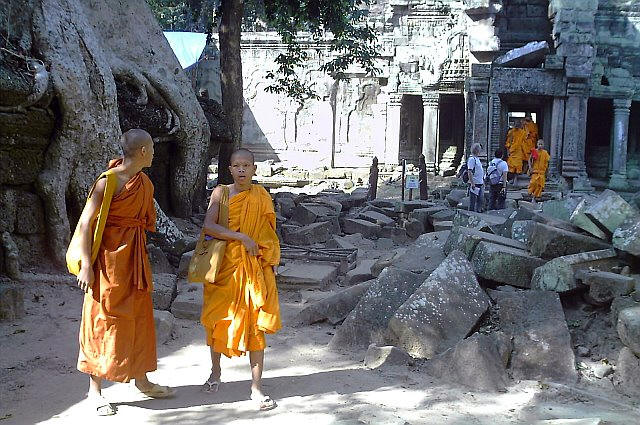
Angkor Wat: Buddhist monks like these are seen everywhere around the
temple compounds.
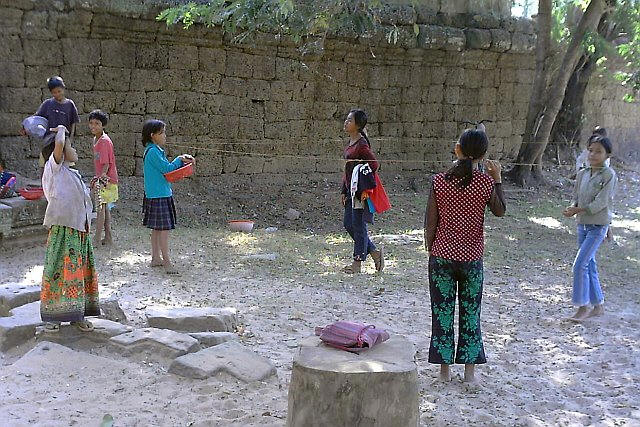
Angkor Wat: While
parents work, children play.
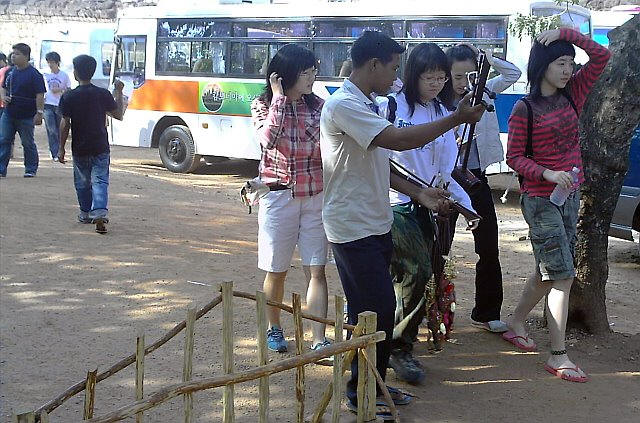
Angkor Wat: Sellers of all ages hang around every place tourists
might want to buy a souvenir.
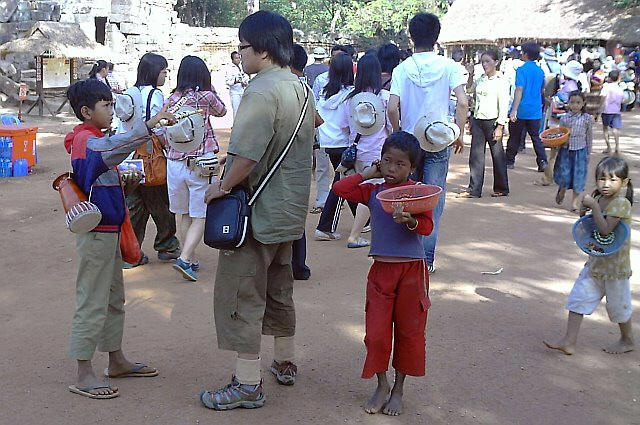
Angkor Wat: Sellers of all ages hang around every place tourists
might want to buy a souvenir.
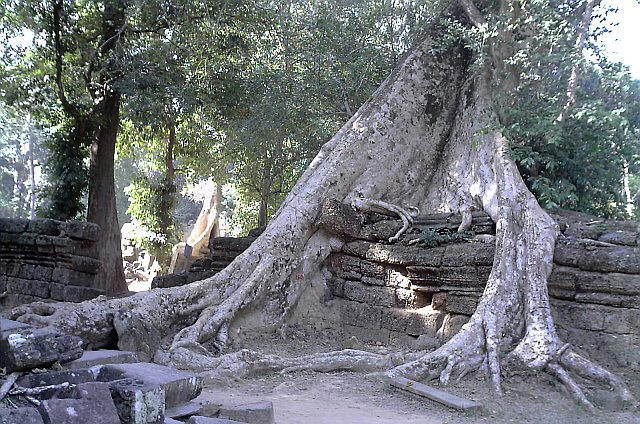
Angkor Wat: Giant roots of trees planted long after the ancient
temples were constructed continue to grow around and through the old
structures.
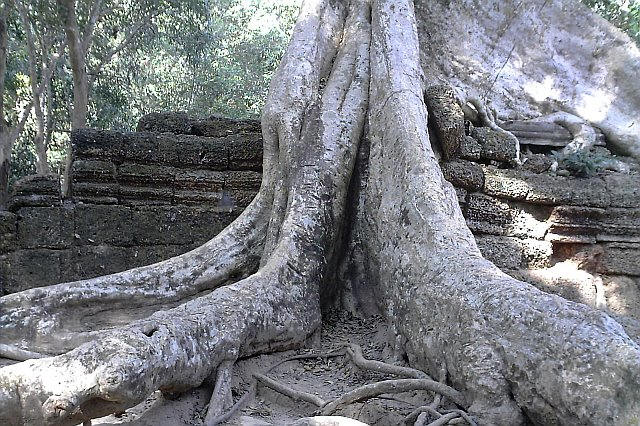
Angkor Wat: Trees planted long after the ancient temples were
constructed continue to grow around and through the old structures.
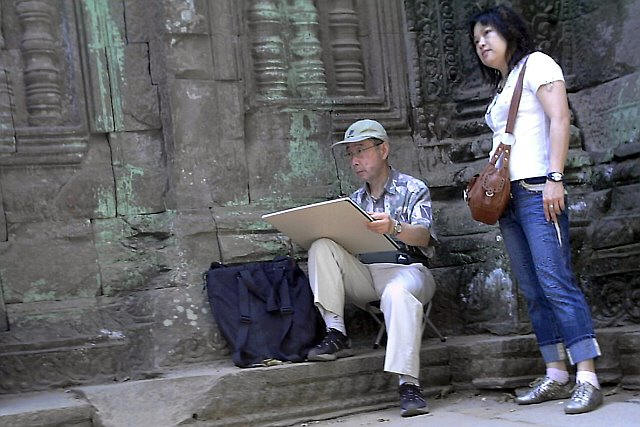
Angkor Wat: Artists sketching exotic subjects around the temple
compounds.
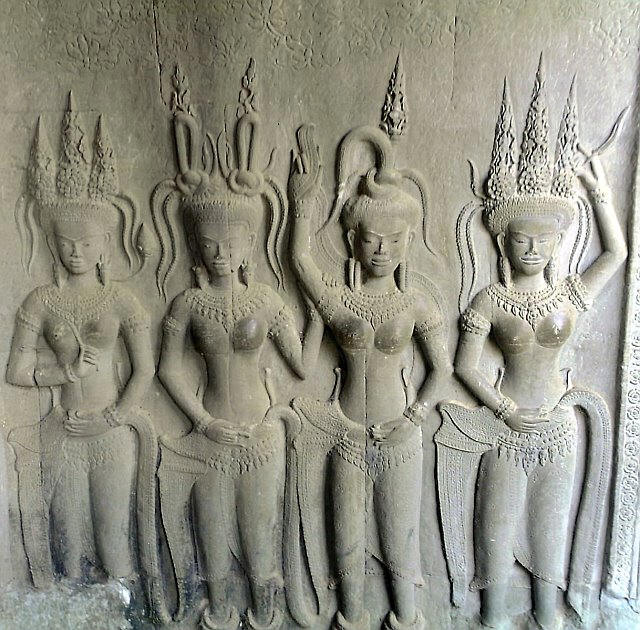
Angkor Wat: Bas relief sculptures like these adorn most flat stone surfaces
around the temple compounds. While similar, no two are alike and even the
models appear to be unique.
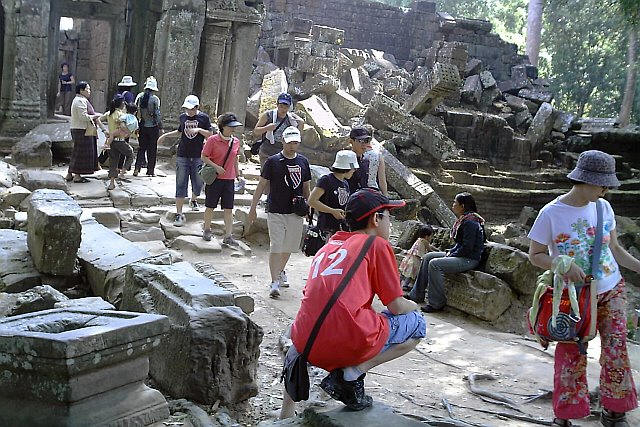
Angkor Wat: Organized tour groups and independent travelers like me
wander around the temple compounds.
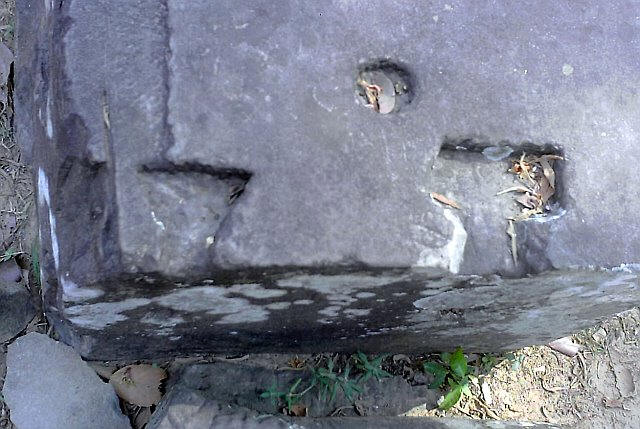
Angkor Wat: Details of the staple system used to bind blocks of
stone together. These depressions were filled with molten metal, a
technique I first saw in Greece, then Italy and later Peru.
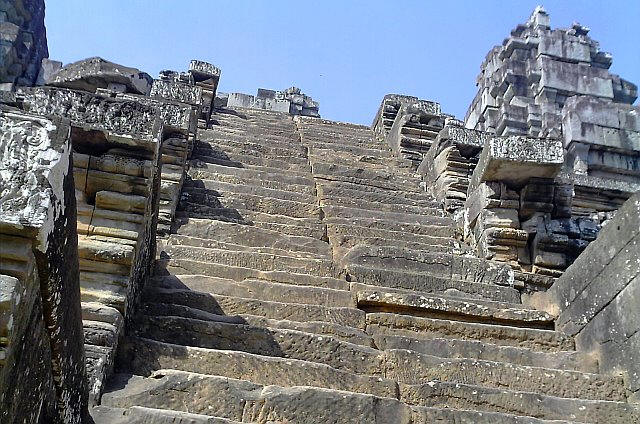
Angkor Wat: Looking up the very steep stairs into the main temple in
the complex, a difficult and dangerous climb.
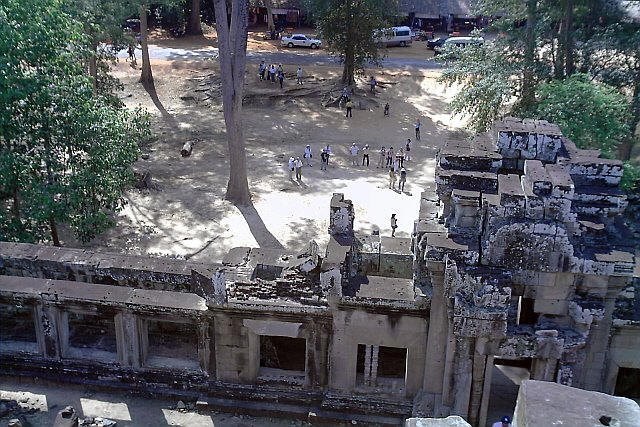
Angkor Wat: Looking down the very steep stairs from the top of the
main temple, a difficult and dangerous climb both ways.
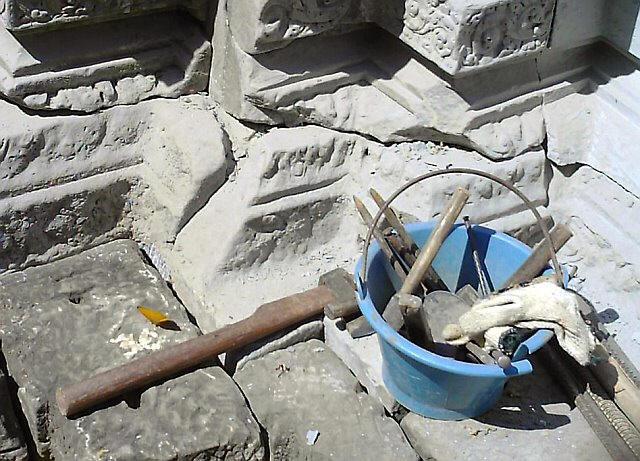
Angkor Wat: Evidence of extensive ongoing restoration and
archeological work under way throughout the monument.
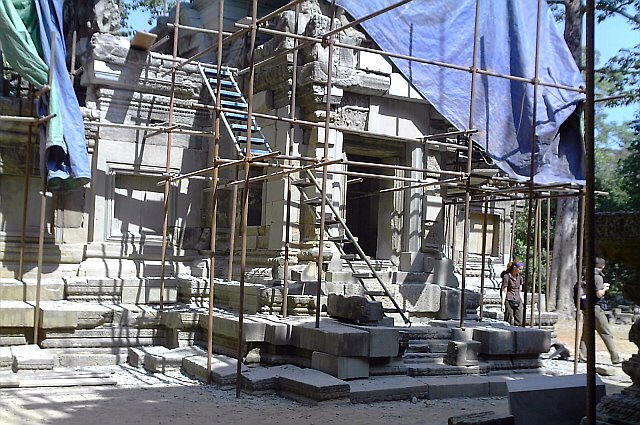
Angkor Wat: Evidence of extensive ongoing restoration and
archeological work under way throughout the monument.
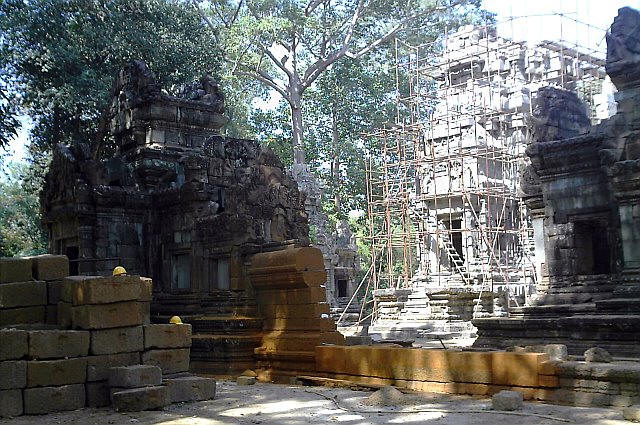
Angkor Wat: Evidence of extensive ongoing restoration and
archeological work under way throughout the monument.
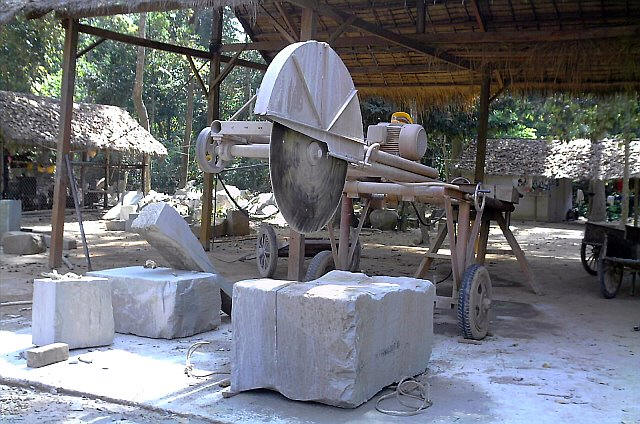
Angkor Wat: Evidence of extensive ongoing restoration and
archeological work under way throughout the monument.
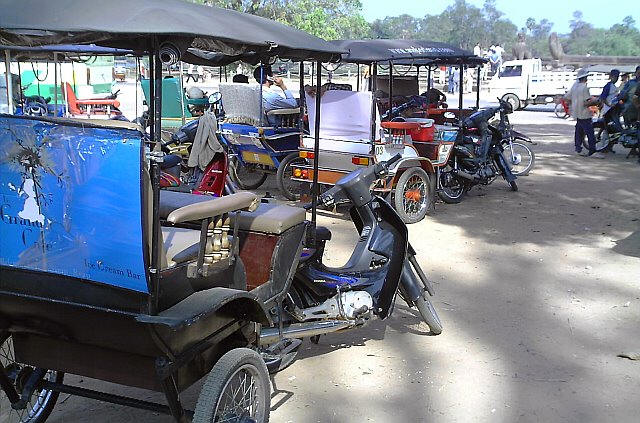
Angkor Wat: My taxi driver waits with others while we tour the ruins
and later enjoyed a quite good lunch in the restaurant near the end
of the entry causeway.
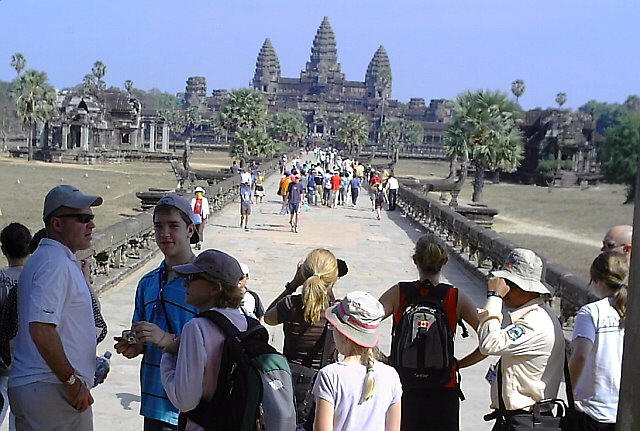
Angkor Wat: Organized tour groups and independent travelers like me
wander around the temple compounds.
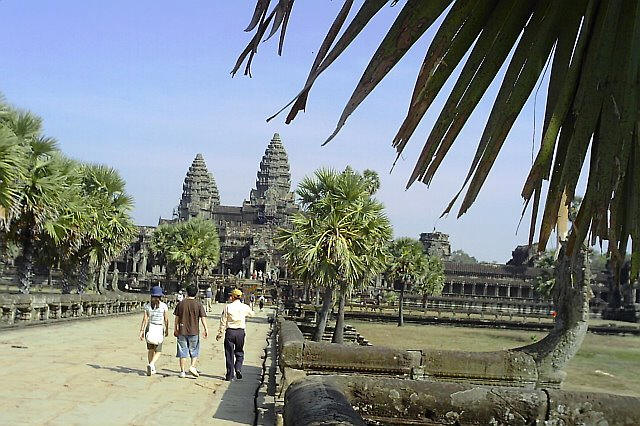
Angkor Wat: Looking in toward the main temple complex from along the
causeway.
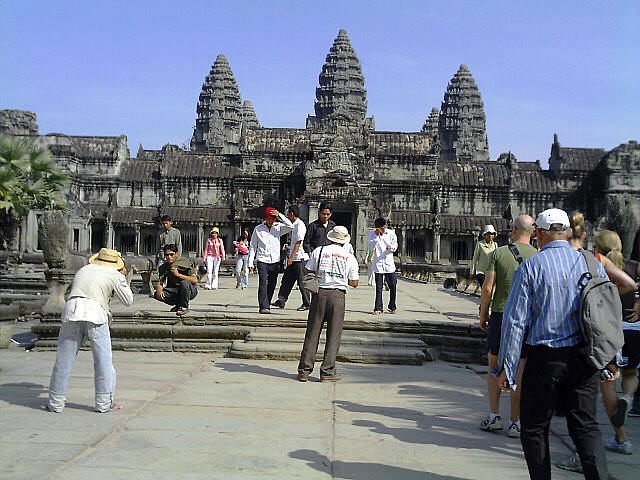
Angkor Wat: An organized tour group prepares to proceed into the
main entryway.
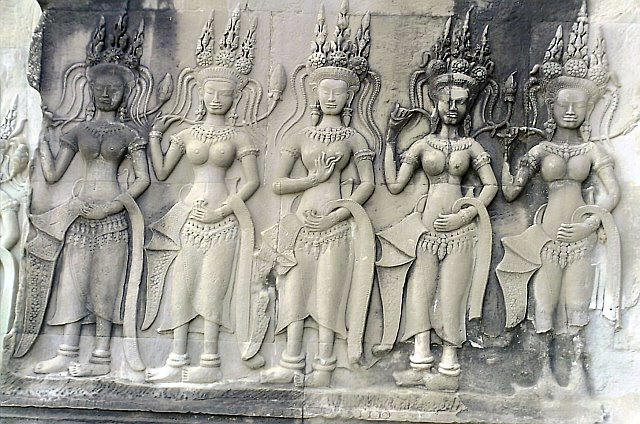
Angkor Wat: Bas relief sculptures like these adorn most flat stone
surfaces around the temple compounds. While similar, no two are
alike and even the models appear to be unique.
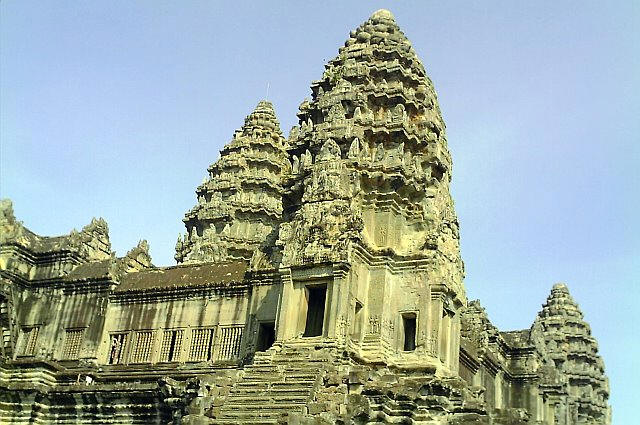
Angkor Wat: Another section of the main temple compound.
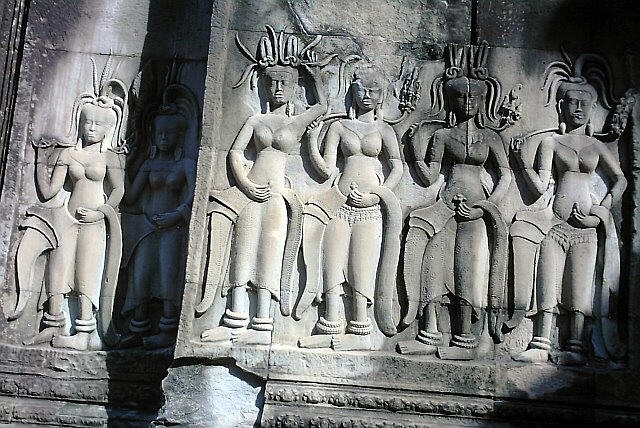
Angkor Wat: Bas relief sculptures like these adorn most flat stone
surfaces around the temple compounds. While similar, no two are
alike and even the models appear to be unique.
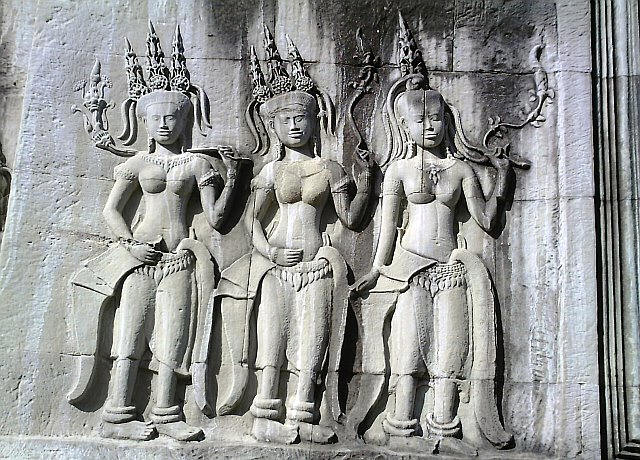
Angkor Wat: Bas relief sculptures like these adorn most flat stone
surfaces around the temple compounds. While similar, no two are
alike and even the models appear to be unique.
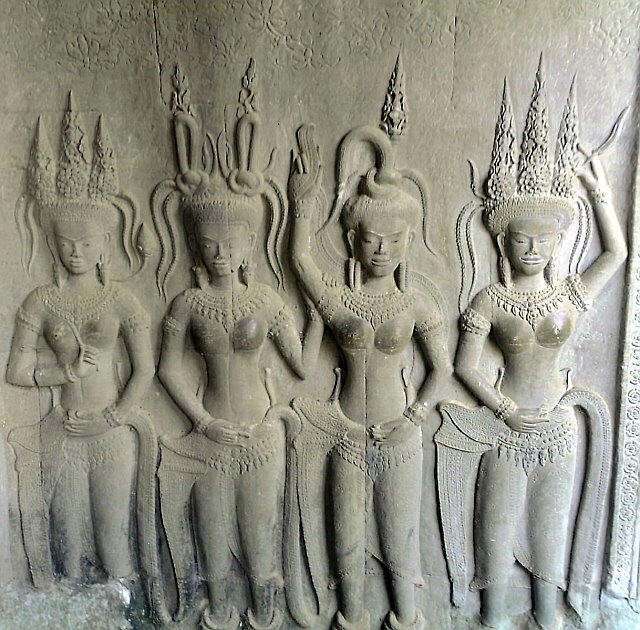
Angkor Wat: Bas relief sculptures like these adorn most flat stone
surfaces around the temple compounds. While similar, no two are
alike and even the models appear to be unique.
|
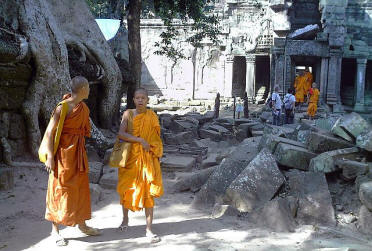
Angkor Wat: Monks in their
orange robes may be seen throughout the monument. Some are tourists;
some are on a pilgrimage and some are "stationed" in the ruins. All
add to the beauty and allure of this ancient place.
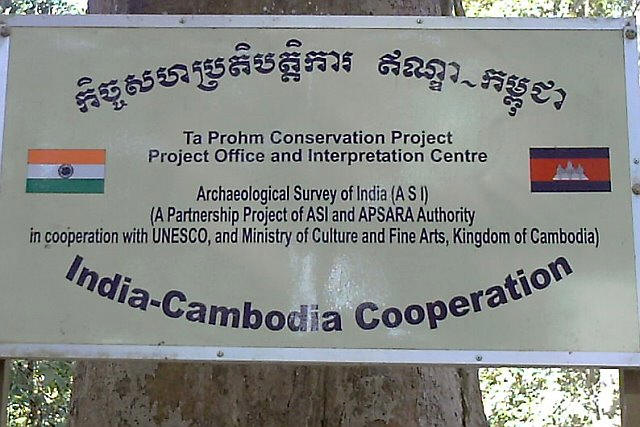
Angkor Wat: Sign identifying an India-Cambodia joint conservation
project.
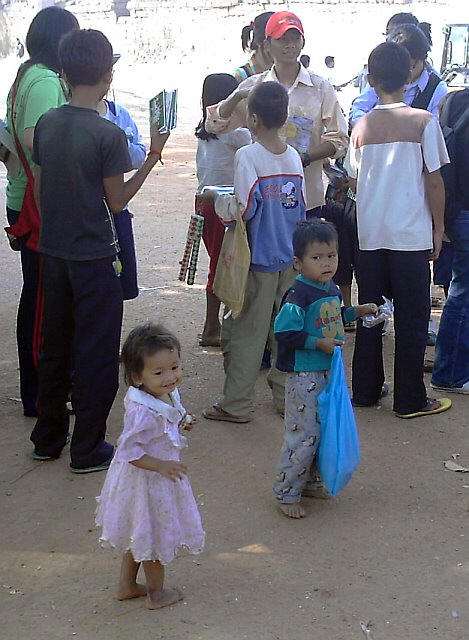
Angkor Wat: Sellers of all ages hang around every place tourists
might want to buy a souvenir.
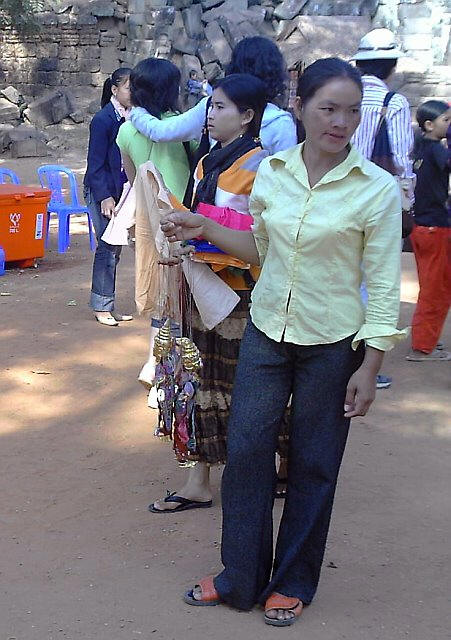
Angkor Wat: Sellers of all ages hang around every place tourists
might want to buy a souvenir.
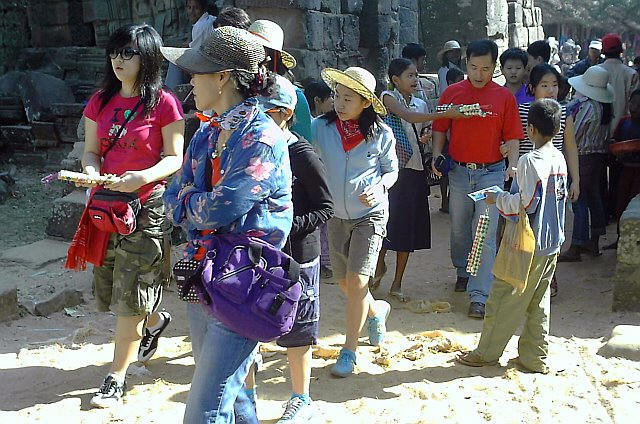
Angkor Wat: Sellers of all ages hang around every place tourists
might want to buy a souvenir.
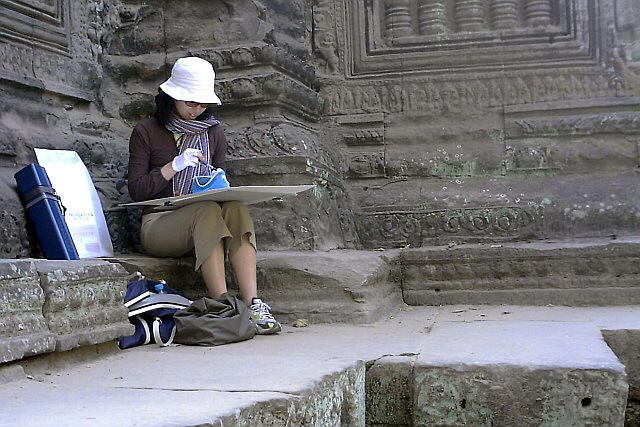
Angkor Wat: Artists sketching exotic subjects around the temple
compounds.
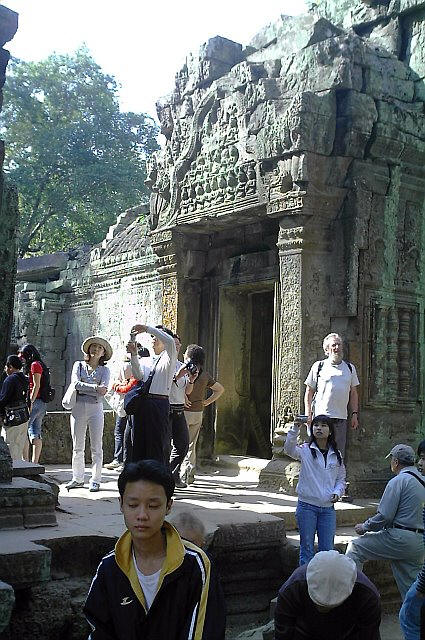
Angkor Wat: Organized tour groups and independent travelers like me
wander around the temple compounds.
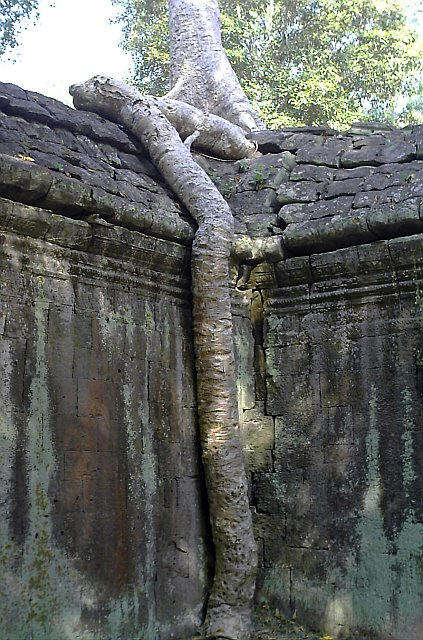
Angkor Wat: Trees planted long after the ancient temples were
constructed continue to grow around and through the old structures.
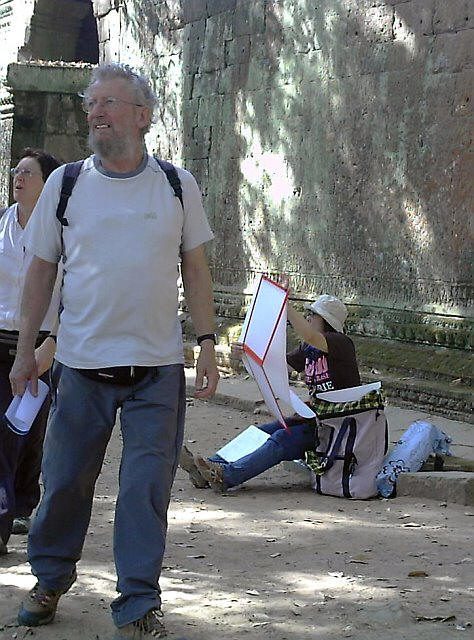
Angkor Wat: Artists sketching exotic subjects around the temple
compounds.
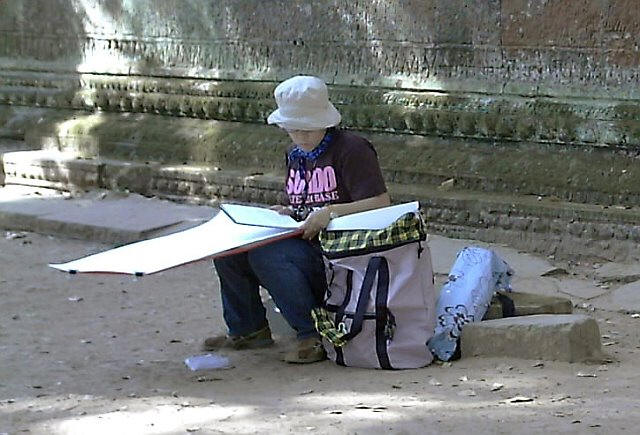
Angkor Wat: Artists sketching exotic subjects around the temple
compounds.
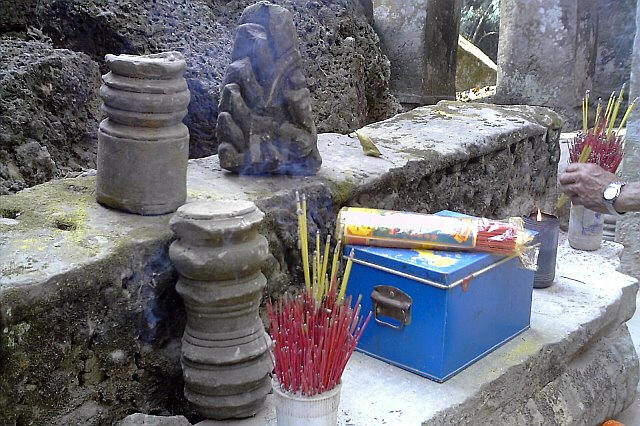
Angkor Wat: Pilgrims and worshippers light incense sticks at many of
the shrines.
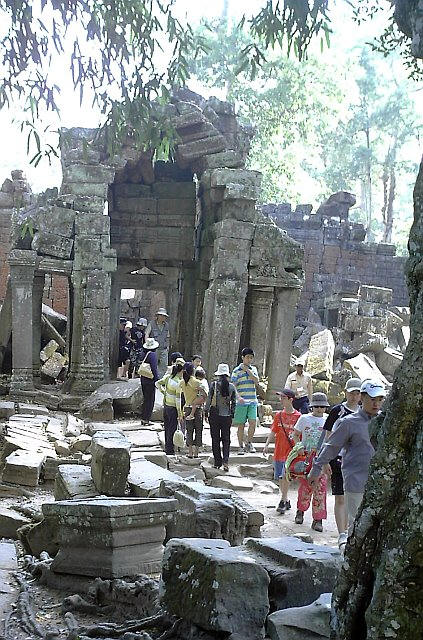
Angkor Wat: Organized tour groups and independent travelers like me
wander around the temple compounds.
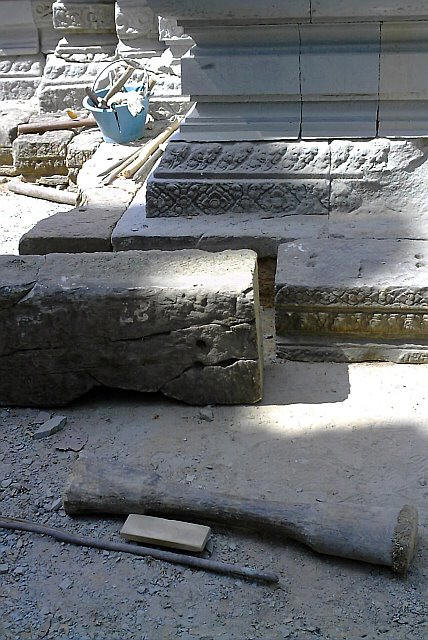
Angkor Wat:
Evidence of extensive ongoing restoration and archeological work
under way throughout the monument.
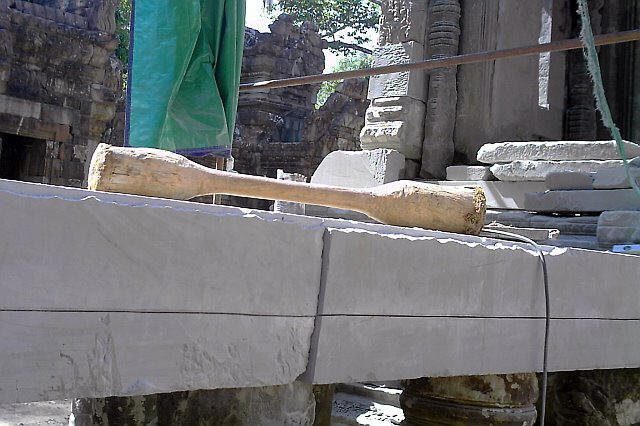
Angkor Wat: Evidence of extensive ongoing restoration and
archeological work under way throughout the monument.
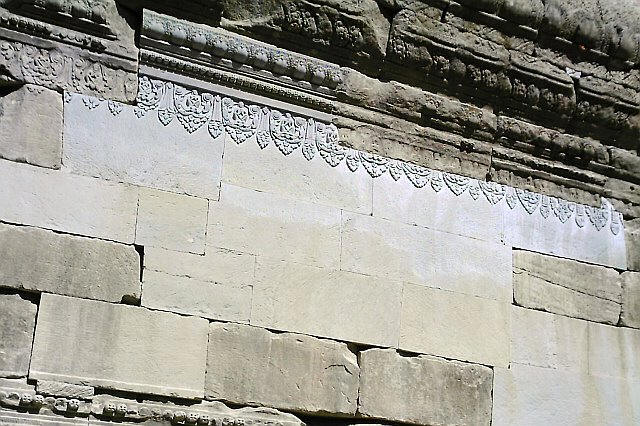
Angkor Wat: Evidence of extensive ongoing restoration and
archeological work under way throughout the monument.
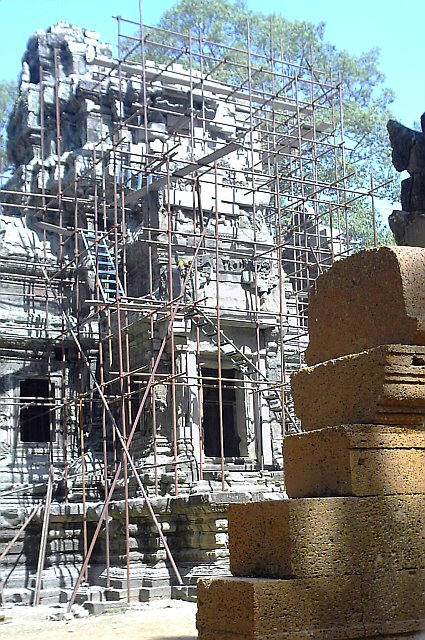
Angkor Wat: Evidence of extensive ongoing restoration and
archeological work under way throughout the monument.
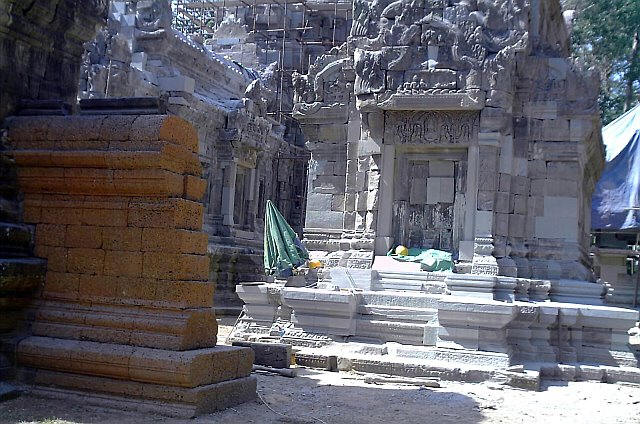
Angkor Wat: Evidence of extensive ongoing restoration and
archeological work under way throughout the monument.
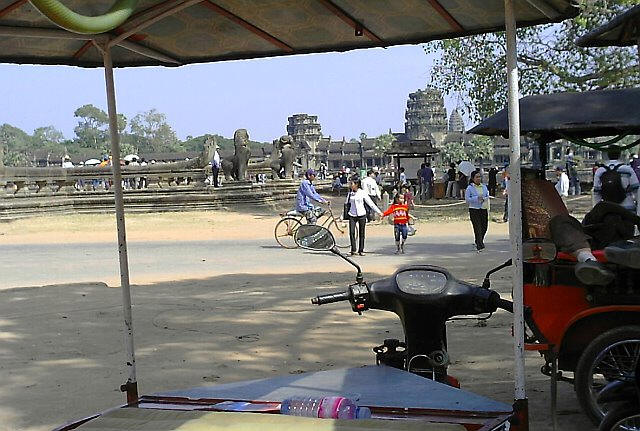
Angkor Wat: Organized tour groups and independent travelers like me
wander around the temple compounds.
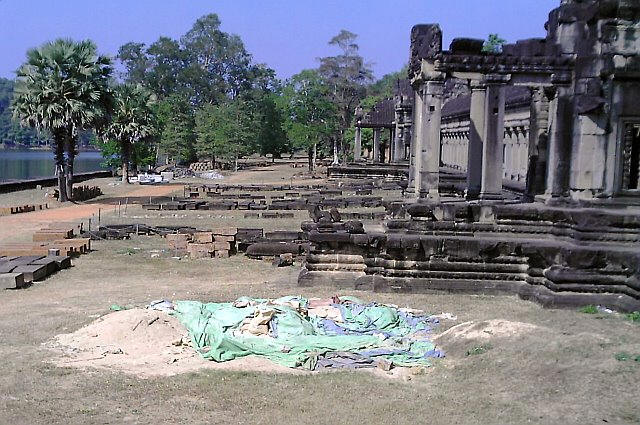
Angkor Wat: More evidence of restoration work underway, this time
near the main entrance along the causeway.
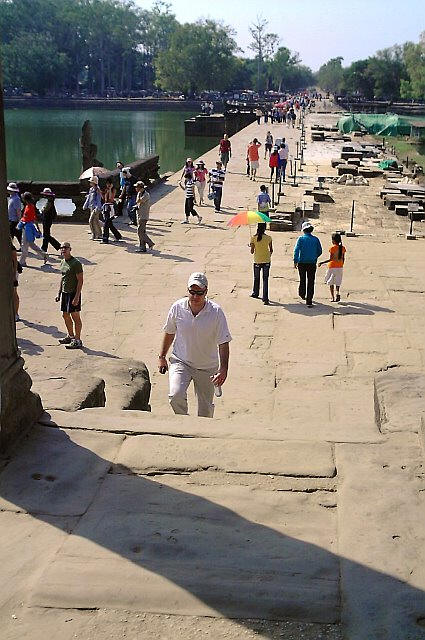
Angkor Wat: Looking back out the entry causeway.
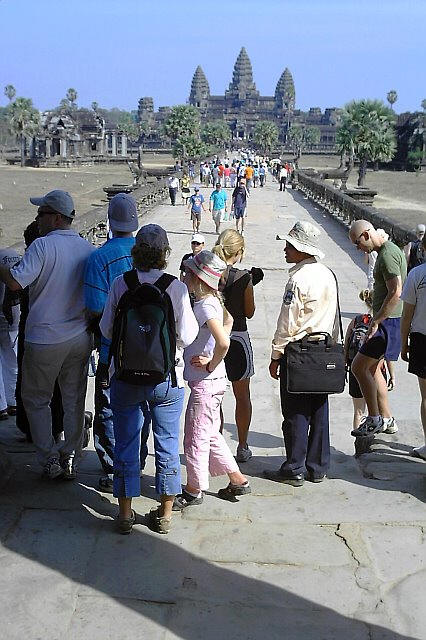
Angkor Wat: Organized tour groups and independent travelers like me
wander around the temple compounds.
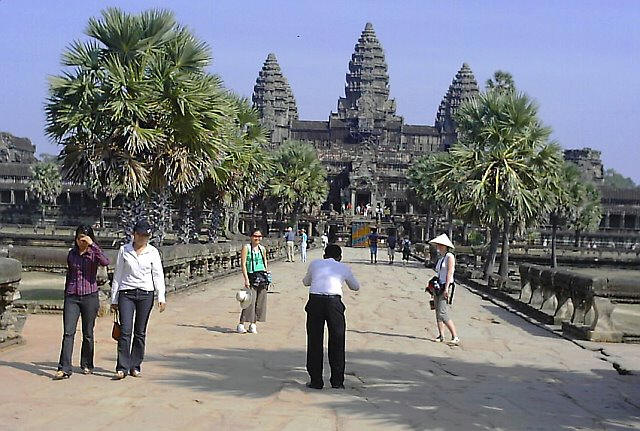
Angkor Wat: Organized tour groups and independent travelers like me
wander around the temple compounds.
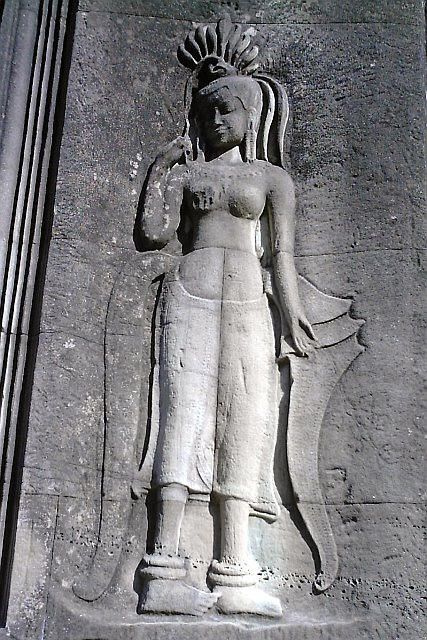
Angkor Wat: Bas relief sculptures like these adorn most flat stone
surfaces around the temple compounds. While similar, no two are
alike and even the models appear to be unique.
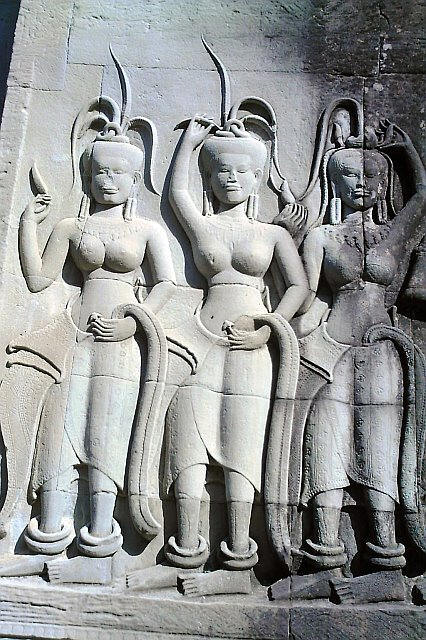
Angkor Wat: Bas relief sculptures like these adorn most flat stone
surfaces around the temple compounds. While similar, no two are
alike and even the models appear to be unique.
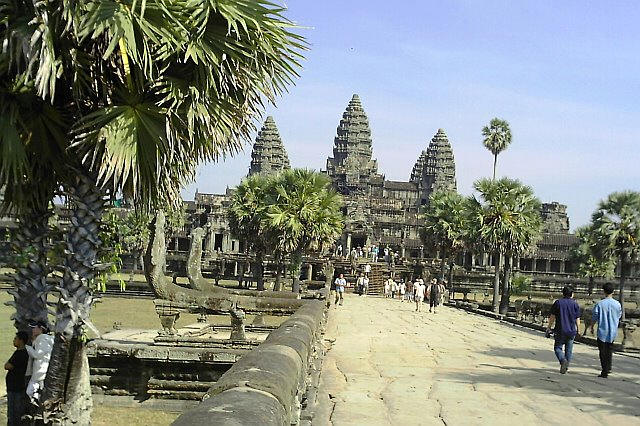
Angkor Wat: Looking in toward the main temple complex from along the
causeway.
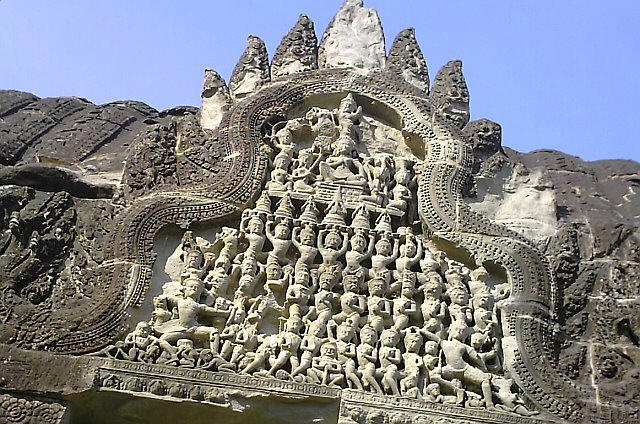
Angkor Wat: Bas relief sculptures like these adorn most flat stone
surfaces around the temple compounds.
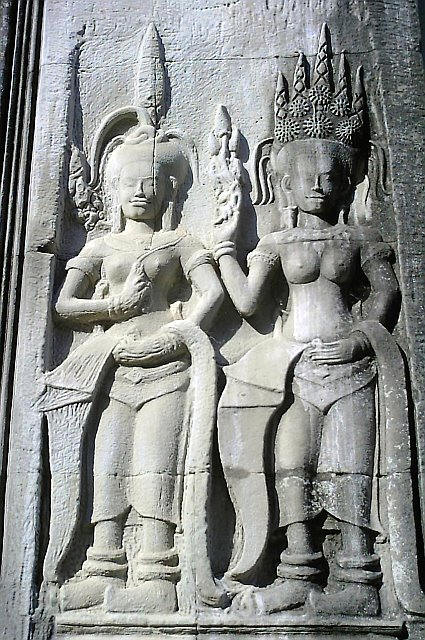
Angkor Wat: Bas relief sculptures like these adorn most flat stone
surfaces around the temple compounds. While similar, no two are
alike and even the models appear to be unique.
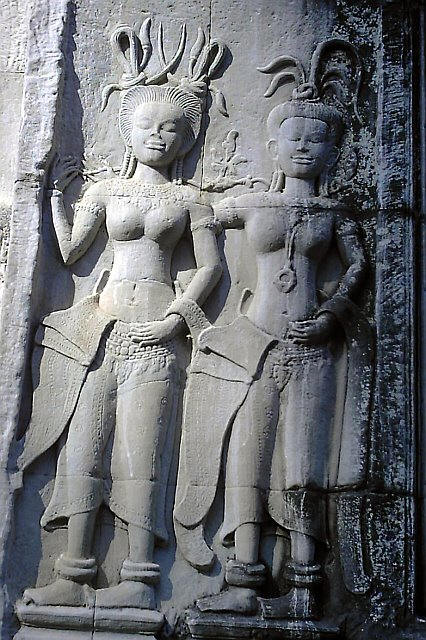
Angkor Wat: Bas relief sculptures like these adorn most flat stone
surfaces around the temple compounds. While similar, no two are
alike and even the models appear to be unique.
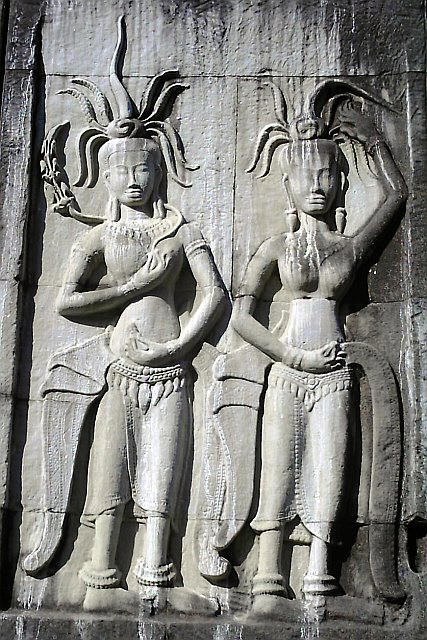
Angkor Wat: Bas relief sculptures like these adorn most flat stone
surfaces around the temple compounds. While similar, no two are
alike and even the models appear to be unique.
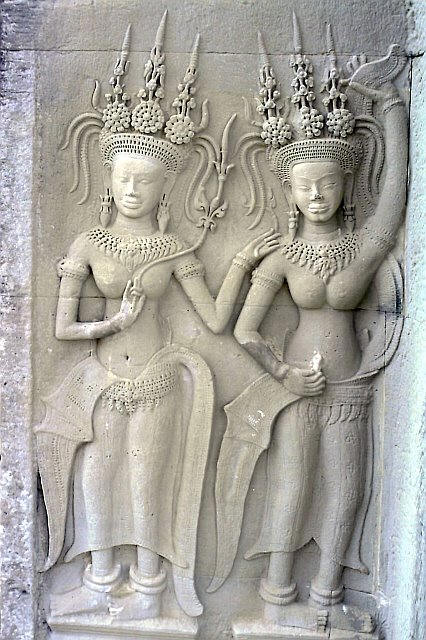
Angkor Wat: Bas relief sculptures like these adorn most flat stone
surfaces around the temple compounds. While similar, no two are
alike and even the models appear to be unique.
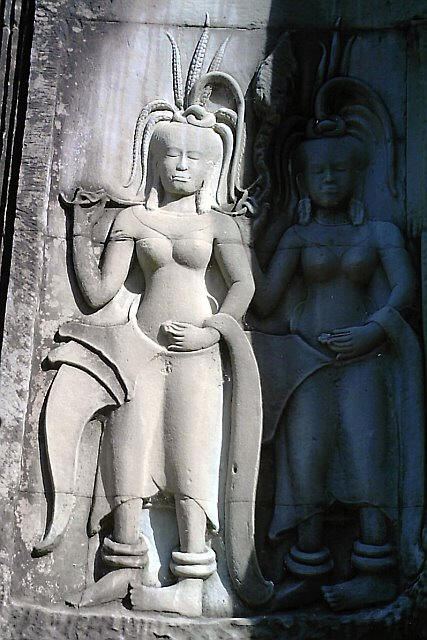
Angkor Wat: Bas relief sculptures like these adorn most flat stone
surfaces around the temple compounds. While similar, no two are
alike and even the models appear to be unique.
|





























































































